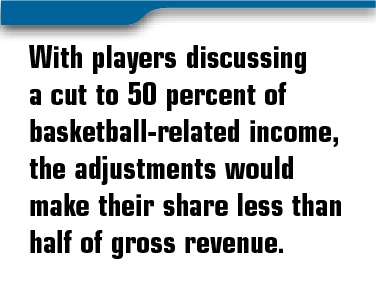While NBA owners and players last week continued to debate the hotly contested issue of basketball-related income, any new labor deal is likely to leave unchanged a formula that last season deducted $500 million before revenue was divided between the two sides.
Gross basketball-related income last year was more than $4.3 billion. From that, about $500 million was deducted to cover expenses related to generating revenue. The balance, $3.817 billion, is what the players and league then split, with 57 percent going to the players for a $2.176 billion share of compensation.
The league and union define basketball-related income as money generated from nearly all revenue sources, including ticket sales, local and national television revenue, and local and national sponsorships. Forty percent of income generated from luxury boxes, signage and arena naming rights goes into BRI, as well. But even beyond that, not every dollar of revenue is counted toward BRI. Instead, expenses incurred by the league for generating certain kinds of revenue are covered up to a predetermined percentage of the revenue. The league and players have agreed on these percentages as being the generally expected expense-to-revenue ratios for the streams, and these percentages are not expected to change in the new labor deal being negotiated.
Specifically, under the expired deal, owners’ expenses were covered for up to 19 percent of the league sponsorship revenue for costs incurred in generating that revenue. The balance of the revenue was then ascribed to the BRI pool and subsequently divided between the owners and players. The owners similarly were covered at up to 22 percent of international TV revenue for related expenses, 34 percent for local sponsorships, and 50 percent for concessions and novelties business. In sum, the expense allocations for the league last year totaled about $500 million, which was subtracted from the total revenue generated before the balance was divided between players (at 57 percent) and owners (43 percent).
With players in last week’s labor talks discussing a reduction from that 57 percent to a 50 percent share, when these expense-related adjustments are factored into the formula, it means the players’ percentage ultimately would be less than half of gross revenue.
“The NBA purported ‘50 percent offer’ is actually an offer to pay the players approximately 44 percent of all revenue,” said National Basketball Players Association lead negotiator Jeffrey Kessler in an email last week. “The reason is that more than $500 million of expenses come off the top.”
NBA executives were not available to comment.
Expense reductions in calculating what shares of revenue players and owners receive are not unusual in sports. Most notably, NFL players under the CBA that expired in March were told that they were receiving 60 percent of league revenue, but that 60 percent was after expense credits were deducted from the gross. What NFL players were actually receiving was about 50 percent of all revenue.
The new NFL CBA changes the way expense reductions are calculated; the prior sum of $1 billion no longer comes off the top. Ultimately, the percentage of all revenue that the players will receive will be about 47 percent, but the percentage can go down from there based on credits and deductions designed to increase revenue for both sides.
While much time was spent during the NFL CBA negotiations changing the economic model of calculating revenue, the NBA talks have not focused on making similar adjustments to their revenue model. Instead, the talks have aimed at the ultimate split of revenue between the league and the players, and the reduction of the players’ share.




